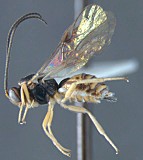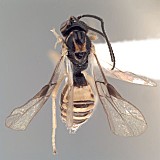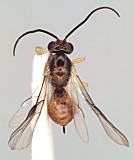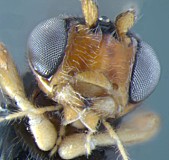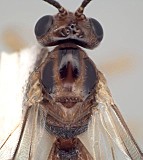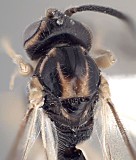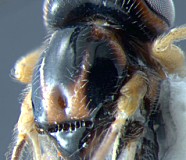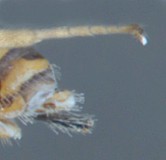Utetes africanus (Szépligeti, 1910)
Taxonomic History / Nomenclature
This species was originally described as Opius africanus by Szepligeti (1910).
It was formally transferred from Opius to Utetes by Wharton (1997). Utetes had been recognized as a subgenus of Opius by Fischer (1972), and later elevated to generic rank by Wharton (1988). However, most of the species were not formally transferred to Utetes until 1997, after Utetes had been redefined (Wharton 1997).
It was formally transferred from Opius to Utetes by Wharton (1997). Utetes had been recognized as a subgenus of Opius by Fischer (1972), and later elevated to generic rank by Wharton (1988). However, most of the species were not formally transferred to Utetes until 1997, after Utetes had been redefined (Wharton 1997).
This species was renamed as Opius tephritivorus by Wharton (1987) when it was discovered that there were two species with the name africanus in the genus Opius. However, with the transfer of this species to Utetes (Wharton 1997), the new name is no longer necessary and the correct name is therefore Utetes africanus (Szépligeti, 1910).
Description
Individuals from Eritrea and Kenya are somewhat darker (e. g. black scutellum) than those from South Africa (usually with yellow scutellum), and Silvestri (1914) used this color difference as the basis for calling the ones from Eritrea a distinct variety: Utetes africanus var. orientalis Silvestri.
Distribution
First described from South Africa. Silvestri (1914) subsequently described a color form from Eritrea that has also been collected in Kenya (Copeland et al. 2004).
Introduced to Italy by Silvestri from material sent to him by Lounsbury in South Africa; released against olive fly, but not established.
Distribution
Native
Eritrea (Back, E. A. and Pemberton, C. E. 1918.; Brues, C. T. 1926.; Cameron, E. 1941.; Delucchi, V. 1957.; Silvestri, F. 1915.; Thompson, W. R. 1953.; Palacio, I. P.; Ibrahim, A. G.; Ibrahim, R. 1988.; Luigifilippo, R. 1967.; Silvestri, F. 1914.; Monaco, R. 1978.; Greathead, D. J. 1971.; Silvestri, F. 1914.; Copeland, R. S.; White, I. M.; Okumu, M.; Machera, P.; Wharton, R. A. 2004.)
South Africa (Back, E. A. and Pemberton, C. E. 1918.; Cameron, E. 1941.; Canovas, C. 1940.; Delucchi, V. 1957.; Szepligeti, G. 1910.; Thompson, W. R. 1953.; Fischer, M. 1988.; Papp, J. 1985.; Palacio, I. P.; Ibrahim, A. G.; Ibrahim, R. 1988.; Neuenschwander, P. 1982.; Monaco, R. 1978.; Fischer, M. 2000.; Copeland, R. S.; White, I. M.; Okumu, M.; Machera, P.; Wharton, R. A. 2004.)
Cape Province (Brues, C. T. 1926.)
Western Cape (Szepligeti, G. 1910.; Fischer, M. 1973.; Silvestri, F. 1914.; Silvestri, F. 1913.)
Introduced
Biology / Hosts
Bactrocera oleae (Rossi), the olive fly.
Other records (Clausen et al. 1965) need confirmation as they may apply to a different species of Utetes that was undescribed at the time those collections were made.
Other records (Clausen et al. 1965) need confirmation as they may apply to a different species of Utetes that was undescribed at the time those collections were made.
Biological Control
This was one of several species field-collected in Africa and shipped to laboratories in France and California as part of a biological control program against olive fly after the latter became established in California in the late 1990s. Studies still on-going as of 2006.
